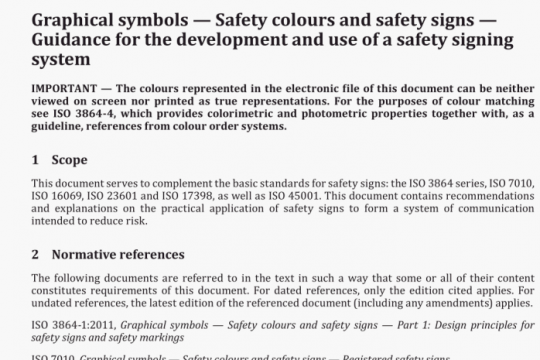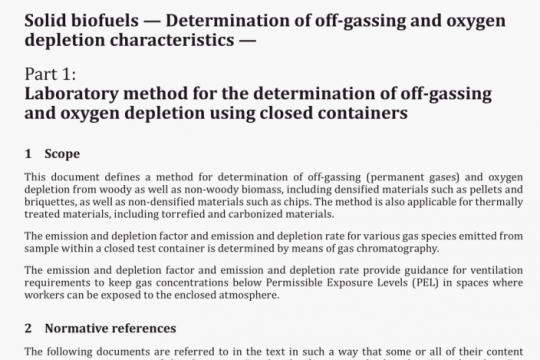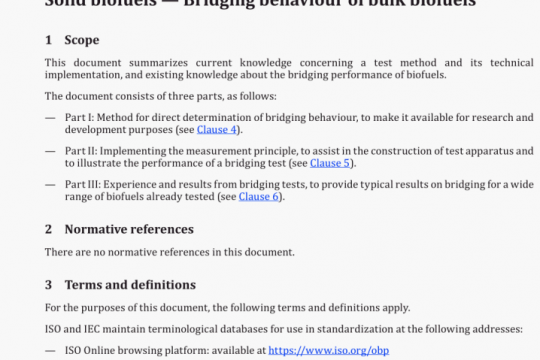ISO 1628-1 pdf free download
ISO 1628-1-2021 pdf free download.Plastics – Determination of the viscosity of polymers in dilute solution using capillary viscometers – Part 1: General principles.
6.2 Concentration
Where no standard exists, careful consideration shall be given to the choice of solvent and the solution concentration. The solution concentration shall be chosen so that the ratio of the efflux time of the solution to the efflux time ofthe solvent is at least 1,2 and less than 20.
NOTE A lower limit of 1,2 ensures sufficient precision ofthe measured difference in efflux times. The upper limit of 2,0 prevents shear effects and non-linearity of the viscosity number in relation to concentration that can occur at higher molecular masses.
More than one concentration can therefore be used for a given polymer/solvent system, depending on the molecular mass ofthe polymer under test.
The concentration is preferably expressed in kg/rn3 ofsolution or as the multiple iO kg/rn3, i.e. g/cm3.
7 Temperature of measurement
The temperature shall be chosen with due regard to sufficient solubility and other technical requirements, but kept constant for any particular polymer/solvent system. The temperature tolerance shall be specified. A temperature of 25 °C ± 0,05 °C shall be chosen whenever possible. If another temperature is used, use the temperature that was agreed between the parties concerned and stated in the test report.
8 Procedure
8.1 General
Measure the efflux times for the solution and the solvent successively in the same viscometer, using the procedure described in Z and
8.2 Preparing and charging the viscometer
8.2.1 Maintain the bath at the specified test temperature.
8.2.2 Charge the dry, clean viscometer (the cleaning procedure is specified in Annex A) by tilting it about 30° from the vertical and pouring sufficient liquid through tube L (see Figure 1 or Figure 2) so that, when the viscometer is returned to the vertical, the meniscus is between the filling marks G and H. Avoid trapping air bubbles in the viscometer. The initial filling may be carried out away from the bath.
8.2.3 Mount the viscometer in a holder in the bath, ensuring that tube N is vertical. Allow time for the charged viscometer to reach the temperature ofthe bath. Usually, 15 mm will suffice ifthe measurement is to be made at 25 °C. At higher temperatures, longer times is necessary. Unnecessary delays should be avoided as it is found that the most consistent results are obtained shortly after temperature equilibrium is attained with a freshly charged viscometer.
8.2.4 This procedure shall also be followed when a measured amount of solvent is added to a solution, already contained in the viscometer, in order to create a more dilute solution for additional determinations. The additional solvent shall be maintained at the specified test temperature prior to use.
8.2.5 In automated equipment, the viscometer is fixed in the vertical position within a temperature- controlled bath and the apparatus is designed to fill the viscometer with liquid in this position. The bath shall be maintained at the specified test temperature and an equilibration time selected in accordance with 8.2.3.
8.3 EffIux time measurement See Figure 1 or Figure 2.
Close tube M and apply suction to tube N, or pressure to tube L, until the liquid reaches a level about
5 mm above mark E. Hold the liquid at this level by closing tube N.
Open tube M so that the liquid drops away from the lower end ofcapillary tube R.
When the liquid is clear of the end of the capillary and the lower end of tube M, open tube N. Measure the efflux time to the nearest 0,2 s as the time taken for the bottom of the meniscus to pass from the top edge of mark E to the top edge of mark F. For polymer solutions containing small amounts of finely divided pigments, such as carbon black, it shall be necessary to view the top of the meniscus. Where large concentrations of pigments are involved, it shall be necessary to centrifuge the solution before proceeding.
The opening and closing ofthe tubes may be carried out conveniently by means oftaps or clips on clean flexible tubing attached to the ends of the tubes, making sure that no fluff or other contaminant enters the tube.
The first flow shall not be taken into account for measuring the efflux time. Repeat the measurement of efflux time immediately, without emptying or recharging, until two successive efflux times agree to within 0,25 %. Take the mean of these two values as the efflux time.
If two successive determinations of the mean efflux time of the solvent differ by more than 0,4 s, clean the viscometer as specified in Annex A.
The efflux time for any “new” solution, created by the addition of solvent to an existing solution held in the viscometer, shall be determined as a separate liquid, in accordance with this procedure.
9 Expression of results
9.1 Reduced viscosity and intrinsic viscosity
Results are preferably expressed as a reduced viscosity.
The reduced viscosity 1, in the units iO m3/kg, i.e. cm3/g, is calculated using Formula (3):
t is the efflux time of the solution, in seconds;
t0 is the efflux time of the solvent, in seconds, through the same viscometer;
c is the concentration, expressed as iO kg/m3, i.e. g/cm3.
The results can also be expressed as an intrinsic viscosity [ij], for example in order to compare copolymers of different average molecular masses for which it has been necessary to use different concentrations (see fL2).
The intrinsic viscosity shall be calculated from the values of inherent viscosity or reduced viscosity obtained for concentrations ci, c2, c3 …, in the approximate ratio 1 : 2 : 3 …, by a graphical method consisting of plotting the inherent-viscosity values or the reduced-viscosity values (on the ordinate axis) against the concentration (on the abscissa) and extrapolating the curve to zero concentration. The intrinsic viscosity is read off the ordinate axis.
It is recommended that the method of least squares be used for analysing the experimental values.ISO 1628-1 pdf download.




